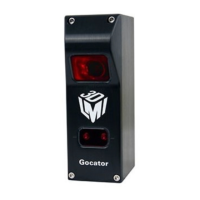Gocator Line Profile Sensors: User Manual
Gocator Web Interface • 126
An indicator on the Alignment panel display ALIGNED or UNALIGNED, depending on the Gocator's
state.
Alignment Types
Gocator sensors support two types of alignment: stationary or moving.
Type Description
Stationary
Stationary is used when the sensor mounting is constant over time and between
scans, for example, when the sensor is mounted in a permanent position over a
conveyor belt.
Moving
Moving is used when the sensor's position relative to the object scanned is
always changing, for example, when the sensor is mounted on a robot arm
moving to different scanning locations.
Alignment: with and without Encoder Calibration
For systems that use an encoder, encoder calibration can be performed while aligning sensors. The table
below summarizes the differences between performing alignment with and without encoder calibration
calibration.
With encoder calibration Without encoder calibration
Target Type Calibration disk or calibration bar Flat surface or calibration bar
Target/Sensor Motion Linear motion Stationary
Calibrates Tilt Yes Yes
Calibrates Z axis Offset Yes Yes
Calibrates X axis Offset Yes Yes (Calibration bar required)
Calibrates Encoder Yes No
Calibrates Travel Speed Yes No
See Coordinate Systems on page 54 for definitions of coordinate axes. See Calibration Targets on page
27 for descriptions of calibration disks and bars.
See Aligning Sensors below for the procedure to perform alignment. After alignment, the coordinate
system for laser profiles will change from sensor coordinates to system coordinates.
Aligning Sensors
Alignment can be used to compensate for mounting inaccuracies by aligning sensor data to a common
reference surface. (In many systems, the reference surface is a conveyor belt.) For more information on
alignment types, see Alignment Types above.
With certain types of alignment, a Degrees of Freedom setting lets you choose the axes on which
offsets and rotations are calculated. If the setting is not available, only X and Z offsets, and Y angle
rotation, are calculated. That is, alignment is only performed within the profile plane. When the Degrees
of Freedom setting is available, it provides options that let you perform alignment outside the profile
plane. For more information, see the procedure on performing moving alignment.
